 All papers examples
All papers examples
Disciplines

- MLA
- APA
- Master's
- Undergraduate
- High School
- PhD
- Harvard
- Biology
- Art
- Drama
- Movies
- Theatre
- Painting
- Music
- Architecture
- Dance
- Design
- History
- American History
- Asian History
- Literature
- Antique Literature
- American Literature
- Asian Literature
- Classic English Literature
- World Literature
- Creative Writing
- English
- Linguistics
- Law
- Criminal Justice
- Legal Issues
- Ethics
- Philosophy
- Religion
- Theology
- Anthropology
- Archaeology
- Economics
- Tourism
- Political Science
- World Affairs
- Psychology
- Sociology
- African-American Studies
- East European Studies
- Latin-American Studies
- Native-American Studies
- West European Studies
- Family and Consumer Science
- Social Issues
- Women and Gender Studies
- Social Work
- Natural Sciences
- Anatomy
- Zoology
- Ecology
- Chemistry
- Pharmacology
- Earth science
- Geography
- Geology
- Astronomy
- Physics
- Agriculture
- Agricultural Studies
- Computer Science
- Internet
- IT Management
- Web Design
- Mathematics
- Business
- Accounting
- Finance
- Investments
- Logistics
- Trade
- Management
- Marketing
- Engineering and Technology
- Engineering
- Technology
- Aeronautics
- Aviation
- Medicine and Health
- Alternative Medicine
- Healthcare
- Nursing
- Nutrition
- Communications and Media
- Advertising
- Communication Strategies
- Journalism
- Public Relations
- Education
- Educational Theories
- Pedagogy
- Teacher's Career
- Statistics
- Chicago/Turabian
- Nature
- Company Analysis
- Sport
- Paintings
- E-commerce
- Holocaust
- Education Theories
- Fashion
- Shakespeare
- Canadian Studies
- Science
- Food Safety
- Relation of Global Warming and Extreme Weather Condition
Paper Types

- Movie Review
- Essay
- Admission Essay
- Annotated Bibliography
- Application Essay
- Article Critique
- Article Review
- Article Writing
- Assessment
- Book Review
- Business Plan
- Business Proposal
- Capstone Project
- Case Study
- Coursework
- Cover Letter
- Creative Essay
- Dissertation
- Dissertation - Abstract
- Dissertation - Conclusion
- Dissertation - Discussion
- Dissertation - Hypothesis
- Dissertation - Introduction
- Dissertation - Literature
- Dissertation - Methodology
- Dissertation - Results
- GCSE Coursework
- Grant Proposal
- Admission Essay
- Annotated Bibliography
- Application Essay
- Article
- Article Critique
- Article Review
- Article Writing
- Assessment
- Book Review
- Business Plan
- Business Proposal
- Capstone Project
- Case Study
- Coursework
- Cover Letter
- Creative Essay
- Dissertation
- Dissertation - Abstract
- Dissertation - Conclusion
- Dissertation - Discussion
- Dissertation - Hypothesis
- Dissertation - Introduction
- Dissertation - Literature
- Dissertation - Methodology
- Dissertation - Results
- Essay
- GCSE Coursework
- Grant Proposal
- Interview
- Lab Report
- Literature Review
- Marketing Plan
- Math Problem
- Movie Analysis
- Movie Review
- Multiple Choice Quiz
- Online Quiz
- Outline
- Personal Statement
- Poem
- Power Point Presentation
- Power Point Presentation With Speaker Notes
- Questionnaire
- Quiz
- Reaction Paper
- Research Paper
- Research Proposal
- Resume
- Speech
- Statistics problem
- SWOT analysis
- Term Paper
- Thesis Paper
- Accounting
- Advertising
- Aeronautics
- African-American Studies
- Agricultural Studies
- Agriculture
- Alternative Medicine
- American History
- American Literature
- Anatomy
- Anthropology
- Antique Literature
- APA
- Archaeology
- Architecture
- Art
- Asian History
- Asian Literature
- Astronomy
- Aviation
- Biology
- Business
- Canadian Studies
- Chemistry
- Chicago/Turabian
- Classic English Literature
- Communication Strategies
- Communications and Media
- Company Analysis
- Computer Science
- Creative Writing
- Criminal Justice
- Dance
- Design
- Drama
- E-commerce
- Earth science
- East European Studies
- Ecology
- Economics
- Education
- Education Theories
- Educational Theories
- Engineering
- Engineering and Technology
- English
- Ethics
- Family and Consumer Science
- Fashion
- Finance
- Food Safety
- Geography
- Geology
- Harvard
- Healthcare
- High School
- History
- Holocaust
- Internet
- Investments
- IT Management
- Journalism
- Latin-American Studies
- Law
- Legal Issues
- Linguistics
- Literature
- Logistics
- Management
- Marketing
- Master's
- Mathematics
- Medicine and Health
- MLA
- Movies
- Music
- Native-American Studies
- Natural Sciences
- Nature
- Nursing
- Nutrition
- Painting
- Paintings
- Pedagogy
- Pharmacology
- PhD
- Philosophy
- Physics
- Political Science
- Psychology
- Public Relations
- Relation of Global Warming and Extreme Weather Condition
- Religion
- Science
- Shakespeare
- Social Issues
- Social Work
- Sociology
- Sport
- Statistics
- Teacher's Career
- Technology
- Theatre
- Theology
- Tourism
- Trade
- Undergraduate
- Web Design
- West European Studies
- Women and Gender Studies
- World Affairs
- World Literature
- Zoology
Charles Edouard Jeanneret-Lecorbusier, Research Paper Example
Hire a Writer for Custom Research Paper
Use 10% Off Discount: "custom10" in 1 Click 👇
You are free to use it as an inspiration or a source for your own work.

Charles Edward Jeanerette- Le Corbusier, who is popularly known as Le Corbusier, was born in October sixth 1887 in La Chaux-De-Fonds, which is a small city located in Neuchatel Canton in the North Western region of Switzerland (Brooks 3). This region is also referred to as the Jura Mountains, and is near to the border of France. He changed his citizenship to French in 1930. He combined writing, architecture, design and urbanization, and is credited for being one of the founders of modern architecture.
Early on in life, he was interested in the visual arts, which he learned at the La-Chaux-De-Fonds art school. His teacher was Charles L’Eplattenier, a former student in Paris and Budapest. During his school days, Le Corbusier was influenced by his architecture teacher, René Chapallaz (Brooks 64).
He travelled across Europe during his early years. In 1907, he travelled to Paris where he came under the employ of Auguste Perret, the founder of reinforced concrete. The following year he moved to Vienna where he trained in architecture with Josef Hoffman. He was employed by the well-known architect Peter Behren in Berlin between 1910 and 1911 (Brooks 96). During this period, he mastered the German language. The latter part of 1911 was spent in journeys through the Balkans where he toured Greece, Bulgaria and Turkey (Le, Corbusier 27).
The period of World War 1 was spent teaching in his former school. This period allowed him to focus on theoretical architectural studies that utilize modern methods. One of the projects was the Domino House, which had an open floor plan made of concrete slabs reinforced by few and slender strengthened concrete columns on the edges containing a stairway leading each floor in each side of the plan. For the next ten years, he pursued this design plan until the founding of the architectural partnership with his cousin Pierre Jeanerette. The collaboration ended in 1950 because of his attitude towards the government of the day (Jencks 231).
Le Corbusier contributed to housing in the slums of Paris by designing houses that were as blocks put on top of one another. The apartments contained a living room, kitchen, bedroom and garden terrace. This project, referred to as Immeubles Villas, was the solution to the overcrowding that was characteristic of French slums during this period (Le, Corbusier and Boesiger 21).
Le Corbusier proceeded into designing whole cities, culminating into his 1922 presentation of the “contemporary city” that had the capacity of three million residents (Brooks 105). His design was characterized by buildings containing sixty floors, office buildings constructed with steel and surrounded with glass, and spacing in the form of rectangles. In the center was the transport terminus that comprised of train and bus terminuses, highway crossings on different levels and finally an airport at the top (Le Corbusier 47). Movement from the tall building led to low zigzag apartment buildings that served as the residence. He believed that wealthy French politicians would support this plan, which resembled the American industrial model.
In his contributions to the journal L’Esprit Nouveau, he campaigned for the utilization of modern methods to raise the standards of living of all inhabitants. He supported his arguments by claiming that it was the only solution to avoid the revolution in the society (Moos 8).
In his “Plan Voisin”, he comes up with the idea of demolishing most parts of central Paris and in its place constructing the structures described in the contemporary city. This proposal was deeply criticized by the French politicians, but at least it offered a solution to the congestion in most parts of the city. He published the Radiant City in the 1930s that diverted from the Contemporary City in that it proposed housing basing on family size and not economic strength.
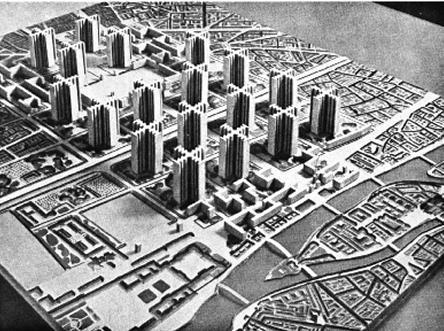
Plan Voisin
`The Villa Savoye, which he designed between 1929 and 1931, summarized his five points of architecture. In this design, the structure is supported by strengthened concrete stilts referred to as pilotis that raise the structure from the ground. His next point was the free façade, which are walls that could be altered randomly by the architect, and then followed by an open floor design, which allowed the construction of rooms without concentrating on the walls (Le Corbusier 107). The fourth point was the sliding windows on the second floor, which gave a full view of the surrounding compound. The last point was the roof garden on the roof that made up for the green area taken by the building.
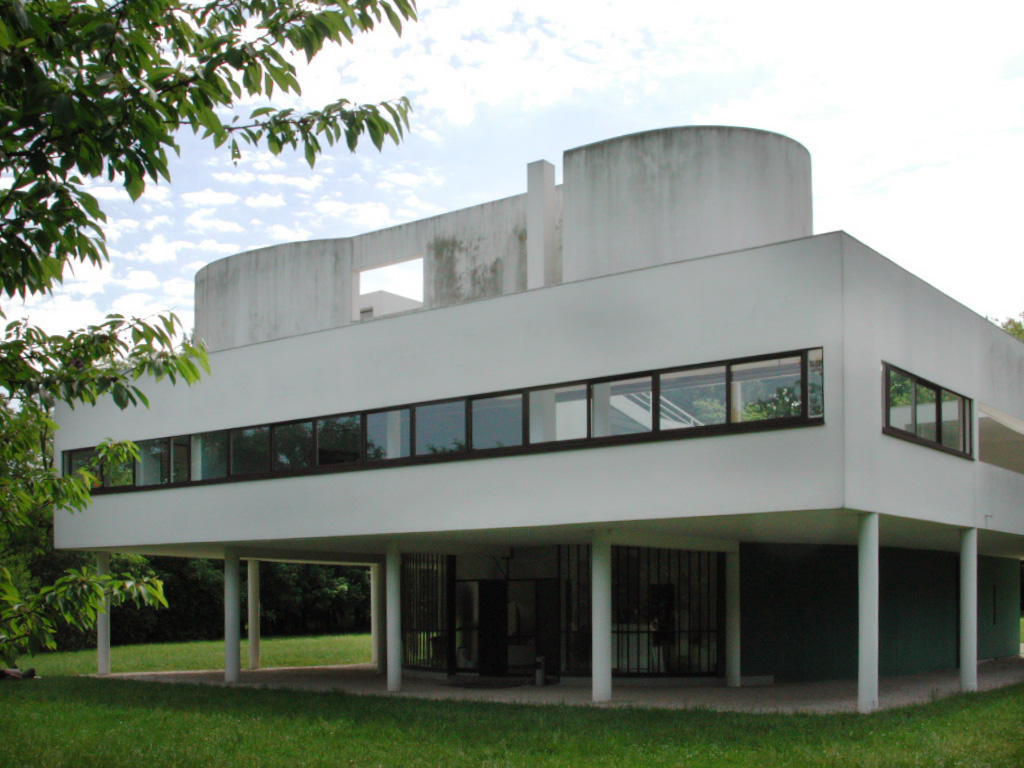
The Villa Savoye
Le Corbusier was concerned with the poor living conditions of the slum dwellers in Paris. He formulated ways of providing quality living conditions for numerous residents. In his Immeubles Villas of 1922, he believed that it would offer a solution to the housing crisis. By designing block like structures on top of one another, he made use of a small space to house many people (Moos 13).
His meeting with the cubist painter Amedee Ozenfant in 1918 resulted into a collaboration in which he started painting. Latter on, the duo-ditched painting claiming that it was unreasonable and “romantic”, and proceeded to publish a joint manifesto titled Après Le Cubism and founded the artistic movement referred to as purism. They founded the purist journal L’Esprit Nouveau.
Some of the architectural designs by le Corbusier in Europe include Pavilion Suisse in Paris, Villa Fallet in Switzerland, Palace of the Soviets in Moscow Russia, Philips Pavilion in Brussels, Villas at Weissenhof estate in Stuttgart Germany and Villa Savoye among others. Le Corbusier was instrumental in the construction of major buildings in Chandigarh, the main administrative center for the Indian states of Punjab and Haryana. He designed the university, the administrative structures and the courts. The plan of the city that divides it into sections was by Le Corbusier. In the Americas, he designed the Maison Errazuriz in Chile, Las Nubes in Salto, Uruguay, Palace of the Ministry of National Health and Education in Rio De Jenairo, and the Carpenter Center for visual Arts at Harvard University, Massachusetts, in the United States of America.
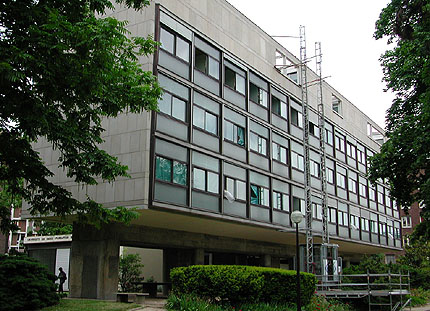
Pavilion Suisse in Paris
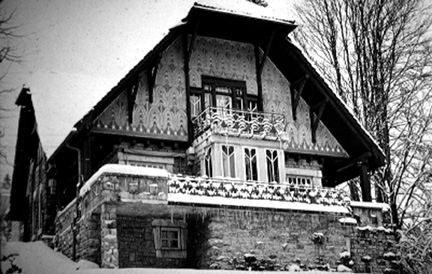
Villa Fallet in Switzerland
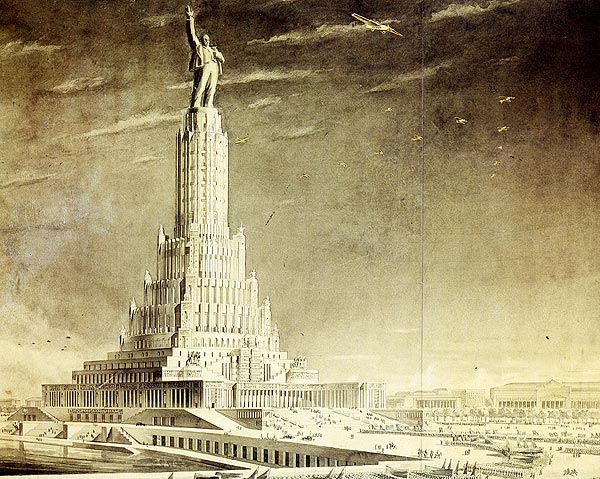
Palace of the Soviets in Moscow Russia
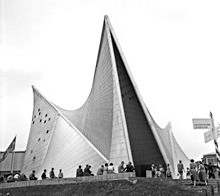
Philips Pavilion in Brussels
The main images in the global map that he designed or aided in designing are the United Nations head quarters in New York City between 1949 and 1952. In this project, he acted as a consultant amongst renowned global architects. His other work was the Philips Pavilion in Brussels, Belgium, in which he collaborated with Lannis Xenaxis. In the United States, he designed the Carpenter Center for Visual Arts at Harvard University (Weber 106).
His favorite quote “you employ stone, wood, and concrete, and with these materials you build houses and palaces: that is construction. Ingenuity is at work. But suddenly you touch my heart, you do me good. I am happy and I say: ‘this is beautiful’. That is architecture. Art enters in …” (Vers une architecture, 1923). This quote is contained in his collection of essays. The book has influenced architecture, serving a theory for architects up to the present.
Works cited
Brooks, Allen. Le Corbusier’s Formative Years: Charles-Edouard Jeanneret at La Chaux-de- Fonds. Chicago: University of Chicago Press, 1999. Print.
Jencks, Charles. “Le Corbusier and the Continual Revolution in Architecture“, The Monacelli Press, 2000.
Le, Corbusier, and W. Boesiger. Oeuvre Comple?te. Basel: Birkha?user, 2006. Print.
Le, Corbusier. Towards a New Architecture. New York: Dover Publications, 1986. Print
Moos, Stanislaus. Le Corbusier: Elements of a Synthesis. New York: 010 Publishers, 2009. Print.
Weber, Nicholas. Le Corbusier: A Life, Alfred A. Knopf, 2008. Print.

Stuck with your Research Paper?
Get in touch with one of our experts for instant help!
Tags:

Time is precious
don’t waste it!
writing help!


Plagiarism-free
guarantee

Privacy
guarantee

Secure
checkout

Money back
guarantee

